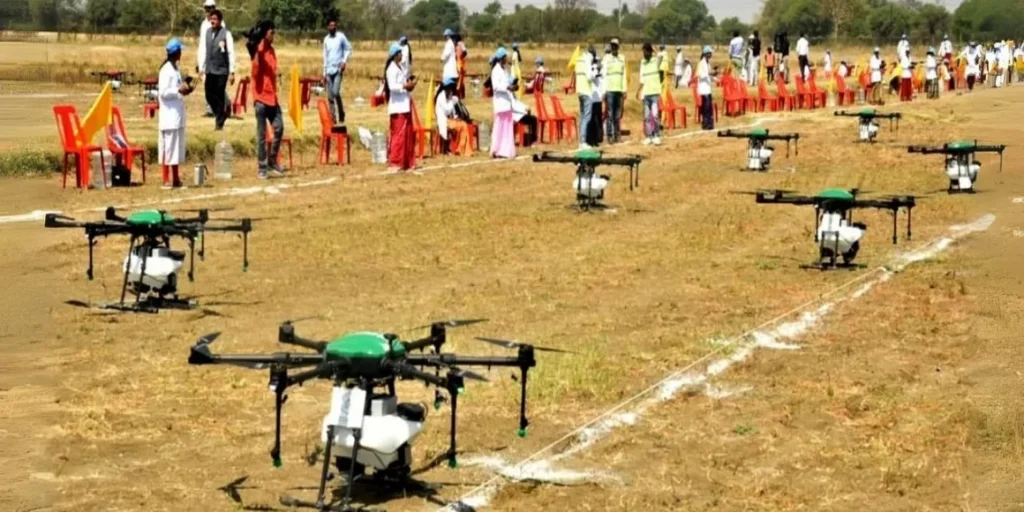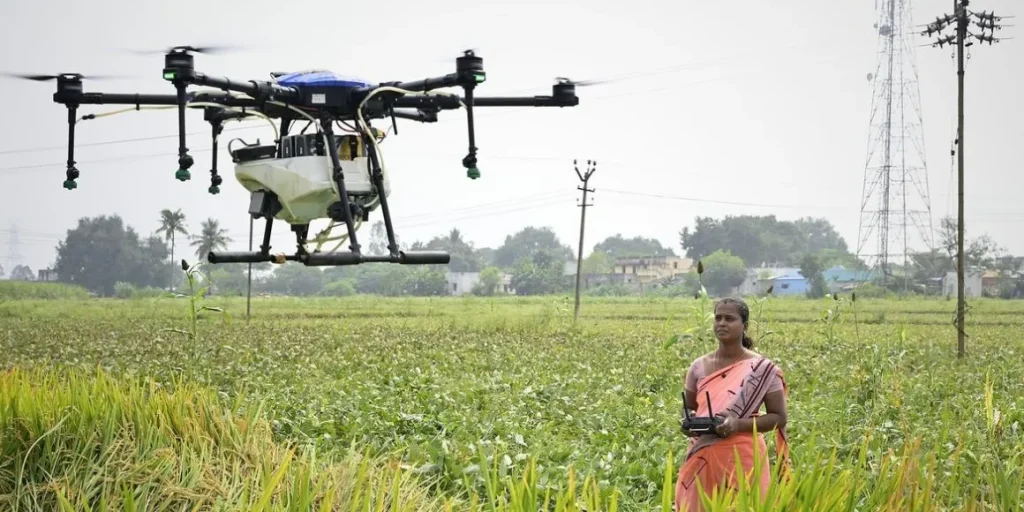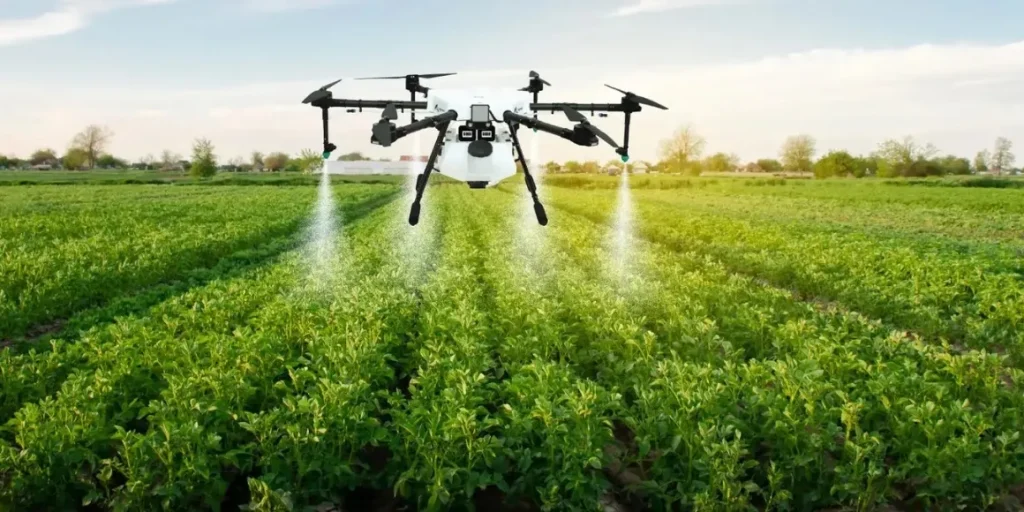India’s agriculture sector has always been the backbone of its economy, but traditional farming methods often limit efficiency, yield, and income. Recognizing the need for innovation and inclusivity, the Government of India launched the Drone Didi Scheme, a pioneering initiative that merges modern drone technology with rural empowerment.
The scheme focuses on providing self-help groups (SHGs), especially women-led groups, access to agricultural drones. By doing so, it creates a dual impact: helping farmers adopt precision farming practices while opening new opportunities for rural women as drone operators, service providers, and entrepreneurs.
For decades, farming in India has been seen as labor-intensive and dependent on outdated practices. The Drone Didi Scheme changes that narrative by equipping women with modern farming tools like drones, which make agriculture more productive, sustainable, and future-ready. Sellers such as Jetayu Gadgets, who supply advanced drones from leading brands like DJI, Autel, Ideaforge, Enzo, Parrot, and Skydio, play an important role in ensuring that SHGs and farmers can access the right equipment for their needs.
This blog will break down how the scheme works, who benefits from it, and why it’s being seen as a gamechanger for both Indian agriculture and women empowerment.
What is the Drone Didi Scheme?

The Drone Didi Scheme, launched by the Government of India, is designed to empower rural women by introducing them to advanced farming tools, particularly agricultural drones. Under this initiative, women-led self-help groups (SHGs) are provided with drones to operate within their communities.
The objective is twofold:
- Boost agricultural efficiency by enabling precise spraying of fertilizers, pesticides, and crop monitoring.
- Create rural entrepreneurship by turning women into trained drone operators and service providers, generating additional income.
Key Features of the Scheme
- Drone allocation: Each SHG receives support to access at least one agricultural drone.
- Training support: Women are trained in drone operation, safety protocols, and basic maintenance.
- Income generation: SHGs can rent out drone services to farmers in their village or nearby areas.
- Government subsidies: The scheme reduces the financial barrier to entry by providing subsidies and support for drone purchases.
This makes it not only a technological revolution but also a social movement that uplifts women in agriculture. By integrating cutting-edge drones from trusted sellers like Jetayu Gadgets, SHGs can choose the right model for their needs, whether it’s for large-scale crop spraying or small farm monitoring.
Interestingly, this move also connects with India’s broader push for agri-tech adoption. In fact, our earlier blog on [How Agriculture Drones Are Transforming Indian Farms: A Guide to the Top Models in 2025] highlights just how crucial drone technology has become for farming efficiency.
Why the Drone Didi Scheme Matters for Women and Rural India

The Drone Didi Scheme is more than just a technology program. It is a social and economic movement that addresses long-standing challenges in rural India, particularly for women.
1. Empowering Women through Skills and Income
Traditionally, women in villages have had limited access to formal employment opportunities. By becoming trained drone operators, women in self-help groups (SHGs) can:
- Offer drone spraying and monitoring services to local farmers.
- Build a steady source of income outside traditional labor-intensive work.
- Gain recognition as community leaders in agri-tech.
2. Increasing Farming Efficiency
Drones significantly reduce time and effort in tasks like crop spraying and field monitoring. What would take a group of farmers several days can now be done in just a few hours with precision. This helps farmers save on labor costs and ensures better crop health.
3. Building Rural Entrepreneurship
With access to drones, SHGs are not just supporting agriculture but also creating micro-business models where drone services can be rented out to multiple farmers in a region. This expands their role from being just support groups to becoming technology-driven entrepreneurs.
4. Supporting Sustainable Agriculture
Drones ensure accurate spraying of fertilizers and pesticides, minimizing wastage and reducing environmental harm. This aligns with India’s broader mission of making farming more sustainable and eco-friendly.
5. Bridging the Tech Gap in Villages
For years, advanced technology seemed out of reach in rural areas. The Drone Didi Scheme is helping to bridge that gap, bringing innovation directly to farmers’ fields.
It also connects to larger discussions around how drones can solve India’s labour crisis in agriculture, a topic we explored in detail in our earlier blog. By reducing dependency on manual labor, the scheme offers both efficiency and resilience for the future of Indian farming.
How the Scheme Works: Process and Eligibility
The Drone Didi Scheme is structured to make advanced farming tools accessible in a simple, step-by-step manner. It ensures that women-led self-help groups (SHGs) not only receive drones but also the knowledge and financial support needed to use them effectively.
Step-by-Step Process
- Identification of SHGs
- Local authorities identify active women-led SHGs in rural areas.
- Groups with a track record of community service and financial management are given preference.
- Access to Drones
- Drones are either purchased directly or arranged through empaneled sellers like Jetayu Gadgets, which provides a wide range of agriculture-focused models from trusted brands.
- Financial support and subsidies reduce the upfront cost burden on SHGs.
- Training and Certification
- Members undergo hands-on training to learn safe drone flying, spraying techniques, and maintenance basics.
- Certification is provided, ensuring they can operate drones in compliance with Indian drone regulations.
- Deployment in Farming Activities
- Drones are put to use for spraying pesticides, fertilizers, and monitoring crop health.
- SHGs begin offering these services to local farmers at affordable rates.
- Revenue Generation and Growth
- Income earned from drone services is shared within the SHG.
- Profits can be reinvested for expansion, drone maintenance, or adding more drones to serve larger areas.
Eligibility Criteria for SHGs
- Must be a registered self-help group with majority women members.
- Should be active in agricultural or allied activities.
- Must be willing to undergo government-supported training for drone operation.
- Preference is given to groups working in regions where farming is a primary livelihood.
Why Sellers Matter in This Process
While the government provides financial backing, access to the right drone models is critical. Sellers like Jetayu Gadgets ensure SHGs can choose from trusted brands—whether they need high-end spraying drones for large farms or lightweight monitoring drones for smaller plots.
For those curious about the rules of flying drones in India, our earlier blog [Can I Fly My Drone Freely or Do I Need a License? Understand the Rules] is a helpful guide to understanding compliance, especially for SHGs planning to operate drones commercially.
Types of Drones Used in the Scheme and Their Benefits

The success of the Drone Didi Scheme largely depends on using the right kind of drones for agricultural purposes. These drones are designed not just for flying, but for solving real problems faced by farmers on the ground.
1. Spraying Drones
- Use: Distribute fertilizers, pesticides, and micronutrients evenly across large fields.
- Benefit: Reduces chemical wastage, ensures uniform coverage, and saves hours of manual spraying.
- Example Models: DJI Agras series, Autel agri drones, Ideaforge Kisan drones.
2. Monitoring Drones
- Use: Capture aerial images and videos of crops to identify pest infestations, irrigation issues, or nutrient deficiencies.
- Benefit: Early detection of crop stress leads to timely intervention and higher yields.
- Example Models: DJI Phantom series, Parrot Bluegrass, Skydio autonomous drones.
3. Mapping and Survey Drones
- Use: Create 2D/3D maps of farmland to analyze soil health, plan irrigation, and monitor crop growth cycles.
- Benefit: Enables precision farming, ensuring resources like water and fertilizers are used efficiently.
- Example Models: DJI Mavic 3 Multispectral, Autel EVO II Pro, Enzo agri drones.
Why Multiple Brands Matter
Since the scheme doesn’t tie SHGs to a single manufacturer, sellers like Jetayu Gadgets play an important role by offering a variety of drone brands and models. This flexibility ensures that every SHG can pick a drone suited to their farm size, crop type, and budget.
In fact, choosing the right drone is often as critical as learning to fly it. Our earlier blog on [Which DJI Drone Is Best for You? Top Picks by Industry & Use Case] dives deeper into how different drones serve different purposes—whether for agriculture, filmmaking, or industrial work.
Impact of the Drone Didi Scheme on Farming Communities
The Drone Didi Scheme is already reshaping how farming is practiced in rural India. Its impact can be seen not only in crop yields and efficiency but also in the lives of women and entire village communities.
1. Better Yields and Reduced Costs
- Drones enable precise spraying, ensuring that every inch of farmland receives the right amount of fertilizer or pesticide.
- Farmers save money by reducing wastage of inputs.
- Timely detection of pests and diseases prevents major crop losses.
2. More Opportunities for Women
- Women who were once confined to household or low-income farm labor now gain recognition as trained drone pilots.
- This shift creates respect within the community and opens doors for rural entrepreneurship.
3. Faster Farming Operations
- Tasks that earlier required 10–15 workers can now be completed in a few hours using drones.
- This reduces dependency on seasonal labor and helps farmers manage larger areas with fewer resources.
4. Strengthening SHGs
- Self-help groups earn steady income by renting out drone services to multiple farmers.
- Profits are shared among members, boosting financial stability within families.
5. Building Tech Confidence in Rural India
- The scheme brings advanced technology directly to villages, helping farmers and women gain confidence in adopting digital tools.
- This exposure also encourages younger generations to see agriculture as a modern, tech-driven profession.
It’s worth noting that these benefits go hand-in-hand with broader changes in agriculture. As we discussed in our blog [How Agri-Tech Companies Are Transforming Indian Farming with Drone Technology], the future of Indian farming lies in making technology accessible to even the smallest farmer. The Drone Didi Scheme is a big step in that direction.
Challenges and Limitations of the Drone Didi Scheme
While the Drone Didi Scheme is a breakthrough initiative, its real-world implementation does face some hurdles. Understanding these challenges is key to improving and scaling the program.
1. High Cost of Drones
- Even with subsidies, agricultural drones remain expensive.
- Maintenance, spare parts, and repairs can add to ongoing costs.
- Many SHGs may still struggle without continuous financial support.
2. Training and Skill Gaps
- Flying a drone safely requires proper certification and practice.
- Some rural areas may lack adequate training centers.
- Without proper guidance, SHGs risk underutilizing or misusing the drones.
3. Regulatory Compliance
- Drones in India are governed by DGCA (Directorate General of Civil Aviation) rules.
- SHGs must ensure they follow regulations on licensing, airspace permissions, and safety.
- Lack of awareness can lead to compliance issues.
4. Technical Issues and Repairs
- Drones need regular calibration, software updates, and careful handling.
- Technical breakdowns can disrupt farming schedules, especially during critical crop cycles.
- Access to reliable repair services in rural areas is still limited, although sellers like Jetayu Gadgets are helping bridge this gap.
5. Resistance to Change
- Some farmers remain skeptical about replacing traditional methods with drones.
- There is often hesitation to trust new technology until clear results are seen.
These challenges highlight why awareness and long-term support are critical for the scheme’s success. For example, in our blog [Got a Broken Drone? Find the Right Repair Store for Agriculture & Creator Drones] we explained how access to quick repairs is essential to keep drone operations running smoothly—a lesson that applies directly to SHGs under this scheme.
The Future of the Drone Didi Scheme in India
The Drone Didi Scheme is still in its early stages, but its long-term potential is significant. If scaled effectively, it can change the face of rural entrepreneurship and modernize Indian agriculture on a large scale.
1. Expansion Across More States
- Currently, the scheme is being rolled out in selected regions.
- Wider adoption across all agricultural states can create a national network of women-led drone operators.
2. Integration with Agri-Tech Ecosystems
- Drones will not work in isolation.
- Future plans may link SHGs with data analytics platforms, IoT devices, and AI-based crop health monitoring.
- This will make precision farming more accessible for even small-scale farmers.
3. Job Creation Beyond Farming
- Trained women drone pilots may find opportunities in construction surveys, mapping, disaster management, and forestry.
- This expands the scheme’s scope beyond agriculture into multiple industries.
4. Building Stronger Drone Infrastructure
- More training centers, repair hubs, and service networks will be needed to support growing adoption.
- Sellers like Jetayu Gadgets, with access to global drone brands, will be critical in ensuring SHGs get the right hardware and after-sales support.
5. Inspiring the Next Generation
- The presence of women drone pilots in rural areas can inspire younger girls to embrace STEM education, drone training, and entrepreneurship.
- This cultural shift could make technology a normal part of rural life.
India’s push for self-reliance in drone technology also complements the scheme. Over the next few years, as local drone manufacturing grows and costs reduce, the Drone Didi Scheme is likely to become even more impactful.
For those considering drone careers, our earlier blog [Is Drone Flying a Good Career in India? Future Scope & Tools You’ll Need to Begin] shows how initiatives like this can open doors to high-demand professions, making the Drone Didi Scheme not just a farming program but a steppingstone for India’s drone economy.
FAQs
Q1. What is the Drone Didi Scheme?
The Drone Didi Scheme is a government initiative that provides agricultural drones to women-led self-help groups (SHGs) to improve farming efficiency and empower women as drone operators and entrepreneurs.
Q2. Who can apply for the scheme?
Women-led self-help groups engaged in agriculture or allied activities are eligible. Preference is given to active groups with a proven track record in community development.
Q3. What kind of drones are provided under the scheme?
The scheme supports spraying drones, monitoring drones, and mapping drones, depending on the needs of farmers. These are sourced from trusted sellers like Jetayu Gadgets, offering multiple brand options.
Q4. How does the scheme benefit farmers?
Farmers gain access to faster and more precise farming methods. Drone spraying saves time, reduces costs, ensures better crop coverage, and increases yields.
Q5. Do SHGs need a license to fly drones?
Yes, SHGs must comply with India’s DGCA regulations. Some drone categories require training and certification. For more details, see our blog on [How to Get a Commercial Drone License in India in 2025 Guide].
Q6. What are the challenges of the Drone Didi Scheme?
High drone costs, training gaps, regulatory awareness, and limited repair infrastructure are some challenges. However, with government support and sellers like Jetayu Gadgets, these challenges are gradually being addressed.
Q7. Can drones under this scheme be used outside agriculture?
Yes. Once trained, women operators can explore opportunities in construction, forestry, surveying, and disaster management, opening new income avenues beyond farming.



